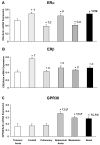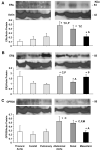Subtype-specific estrogen receptor-mediated vasodilator activity in the cephalic, thoracic, and abdominal vasculature of female rat
- PMID: 23429596
- PMCID: PMC3664271
- DOI: 10.1097/FJC.0b013e31828bc88a
Subtype-specific estrogen receptor-mediated vasodilator activity in the cephalic, thoracic, and abdominal vasculature of female rat
Abstract
Estrogen receptors (ERs) mediate genomic and nongenomic vasodilator effects, but estrogen therapy may not provide systemic vascular protection. To test whether this is because of regional differences in ER distribution or vasodilator activity, cephalic (carotid artery), thoracic (thoracic aorta and pulmonary artery), and abdominal arteries (abdominal aorta, mesenteric artery, and renal artery) from female Sprague-Dawley rats were prepared to measure contraction to phenylephrine and relaxation to acetylcholine (ACh) and the ER activators 17β-estradiol (E2) (all ERs), 4,4',4″-(4-propyl-[1H]-pyrazole-1,3,5-triyl)-tris-phenol (PPT) (ERα), diarylpropionitrile (DPN) (ERβ), and (±)-1-[(3aR*,4S*,9bS*)-4-(6-bromo-1,3-benzodioxol-5-yl)-3a,4,5,9b-tetrahydro-3H-cyclopenta[c]quinolin-8-yl]-ethanone (G1) (GPR30). Phenylephrine caused contraction that was enhanced in endothelium-denuded aorta, supporting endothelial release of vasodilators. In cephalic and thoracic arteries, ACh relaxation was abolished by the nitric oxide (NO) synthase inhibitor Nω-nitro-L-arginine methyl ester (L-NAME), suggesting a role of NO. In mesenteric vessels, ACh-induced relaxation was partly inhibited by the L-NAME + cyclooxygenase inhibitor indomethacin and blocked by the K+ channel blocker tetraethylammonium, suggesting a hyperpolarization pathway. E2 and PPT caused similar relaxation in all vessels. DPN and G1 caused smaller relaxation that was more prominent in abdominal vessels. Reverse transcription-polymerase chain reaction revealed variable ERα messenger RNA expression and increased ERβ in carotid artery and GPR30 in abdominal arteries. Western blots revealed greater amounts of ERα, ERβ, and GPR30 in abdominal arteries. In thoracic aorta, E2-, PPT-, and DPN-induced relaxation was blocked by L-NAME and was associated with increased nitrite/nitrate production, suggesting a role of NO. In abdominal vessels, E2-, PPT-, DPN-, and G1-induced relaxation persisted in L-NAME + indomethacin + tetraethylammonium-treated or endothelium-denuded arteries, suggesting direct effect on vascular smooth muscle. E2, PPT, DPN, and G1 caused greater relaxation of KCl-induced contraction in abdominal vessels, suggesting inhibitory effects on Ca2+ entry. Thus, E2 and ERα stimulation produces similar relaxation of the cephalic, thoracic, and abdominal arteries. In the cephalic and thoracic arteries, particularly the thoracic aorta, E2-induced and ERα- and ERβ-mediated vasodilation involves NO production. ERβ- and GPR30-mediated relaxation is greater in the abdominal arteries and seems to involve hyperpolarization and inhibition of vascular smooth muscle Ca2+ entry. Specific ER agonists could produce vasodilation in specific vascular beds without affecting other vessels in the systemic circulation.
Figures












Similar articles
-
Estrogen Receptors and Estrogen-Induced Uterine Vasodilation in Pregnancy.Int J Mol Sci. 2020 Jun 18;21(12):4349. doi: 10.3390/ijms21124349. Int J Mol Sci. 2020. PMID: 32570961 Free PMC article. Review.
-
Adaptive increases in expression and vasodilator activity of estrogen receptor subtypes in a blood vessel-specific pattern during pregnancy.Am J Physiol Heart Circ Physiol. 2015 Nov 15;309(10):H1679-96. doi: 10.1152/ajpheart.00532.2015. Epub 2015 Sep 25. Am J Physiol Heart Circ Physiol. 2015. PMID: 26408543 Free PMC article.
-
Estrogen receptor subtypes mediate distinct microvascular dilation and reduction in [Ca2+]I in mesenteric microvessels of female rat.J Pharmacol Exp Ther. 2015 Feb;352(2):291-304. doi: 10.1124/jpet.114.219865. Epub 2014 Dec 3. J Pharmacol Exp Ther. 2015. PMID: 25472954 Free PMC article.
-
Estrogen receptor-mediated enhancement of venous relaxation in female rat: implications in sex-related differences in varicose veins.J Vasc Surg. 2010 Apr;51(4):972-81. doi: 10.1016/j.jvs.2009.11.074. J Vasc Surg. 2010. PMID: 20347696 Free PMC article.
-
Potential approaches to enhance the effects of estrogen on senescent blood vessels and postmenopausal cardiovascular disease.Cardiovasc Hematol Agents Med Chem. 2010 Jan;8(1):29-46. doi: 10.2174/187152510790796156. Cardiovasc Hematol Agents Med Chem. 2010. PMID: 20210774 Free PMC article. Review.
Cited by
-
GPR30 decreases with vascular aging and promotes vascular smooth muscle cells maintaining differentiated phenotype and suppressing migration via activation of ERK1/2.Onco Targets Ther. 2016 Jun 7;9:3415-22. doi: 10.2147/OTT.S104972. eCollection 2016. Onco Targets Ther. 2016. PMID: 27354813 Free PMC article.
-
Estrogen Receptors and Estrogen-Induced Uterine Vasodilation in Pregnancy.Int J Mol Sci. 2020 Jun 18;21(12):4349. doi: 10.3390/ijms21124349. Int J Mol Sci. 2020. PMID: 32570961 Free PMC article. Review.
-
Adaptive increases in expression and vasodilator activity of estrogen receptor subtypes in a blood vessel-specific pattern during pregnancy.Am J Physiol Heart Circ Physiol. 2015 Nov 15;309(10):H1679-96. doi: 10.1152/ajpheart.00532.2015. Epub 2015 Sep 25. Am J Physiol Heart Circ Physiol. 2015. PMID: 26408543 Free PMC article.
-
17β-estradiol reduces Cav 1.2 channel abundance and attenuates Ca2+ -dependent contractions in coronary arteries.Pharmacol Res Perspect. 2017 Oct;5(5):e00358. doi: 10.1002/prp2.358. Pharmacol Res Perspect. 2017. PMID: 28971605 Free PMC article.
-
Classical estrogen receptors and ERα splice variants in the mouse.PLoS One. 2013 Aug 5;8(8):e70926. doi: 10.1371/journal.pone.0070926. Print 2013. PLoS One. 2013. PMID: 23940668 Free PMC article.
References
-
- Barrett-Connor E, Bush TL. Estrogen and coronary heart disease in women. JAMA. 1991;265(14):1861–1867. - PubMed
-
- Gerhard M, Ganz P. How do we explain the clinical benefits of estrogen? From bedside to bench. Circulation. 1995;92(1):5–8. - PubMed
-
- Dubey RK, Imthurn B, Zacharia LC, Jackson EK. Hormone replacement therapy and cardiovascular disease: what went wrong and where do we go from here? Hypertension. 2004;44(6):789–795. - PubMed
-
- Orshal JM, Khalil RA. Gender, sex hormones, and vascular tone. Am J Physiol Regul Integr Comp Physiol. 2004;286(2):R233–249. - PubMed
-
- Mendelsohn ME, Karas RH. Molecular and cellular basis of cardiovascular gender differences. Science. 2005;308(5728):1583–1587. - PubMed
Publication types
MeSH terms
Substances
Grants and funding
LinkOut - more resources
Full Text Sources
Other Literature Sources
Miscellaneous

